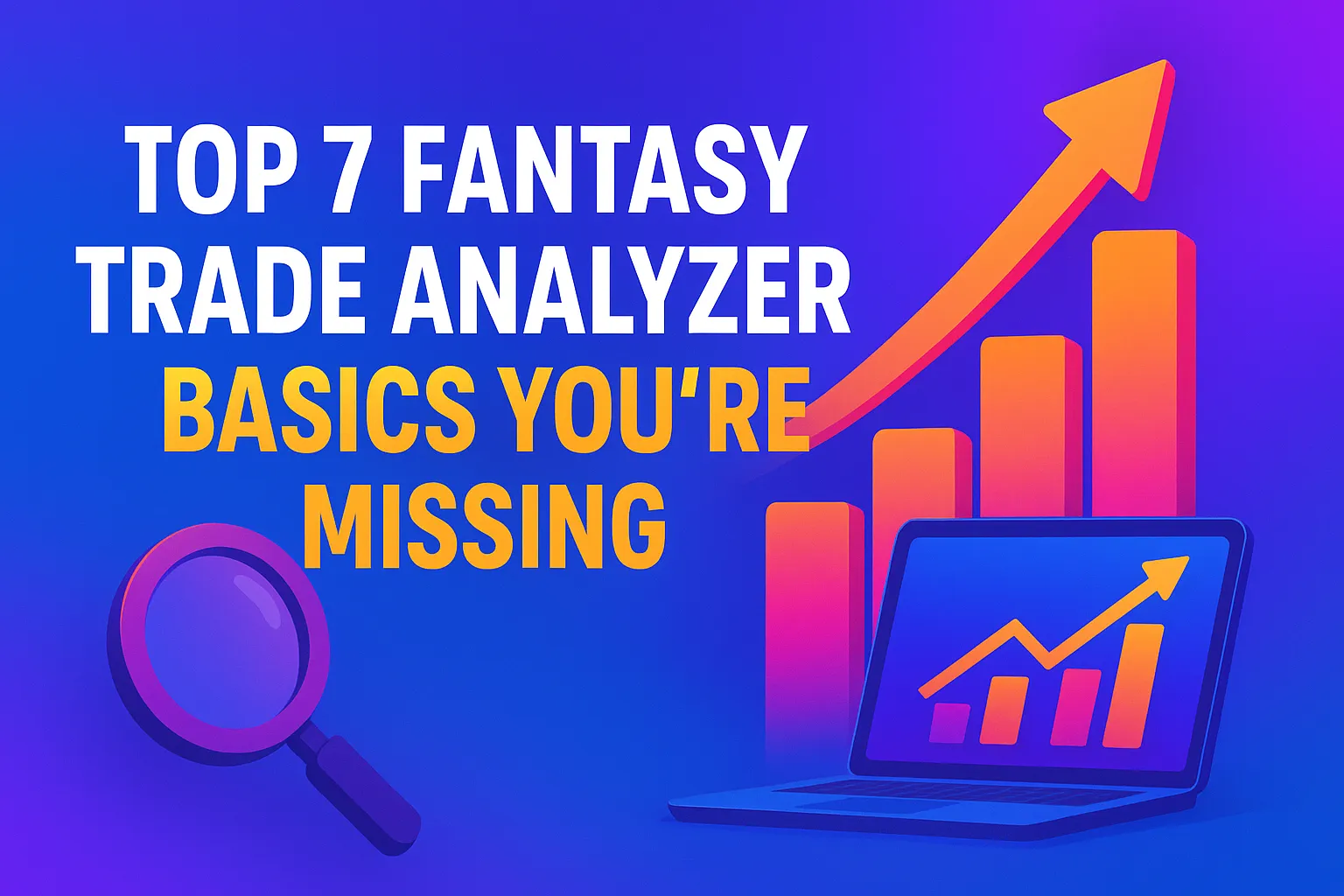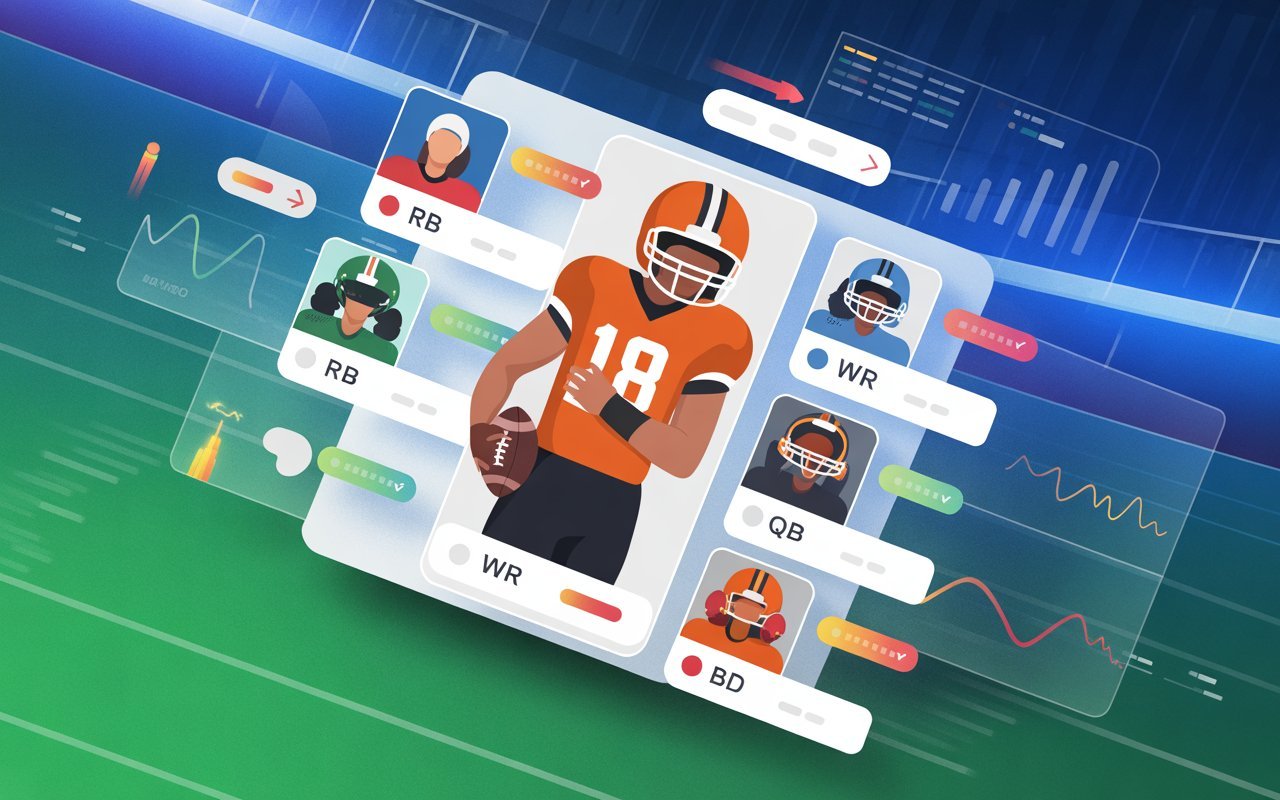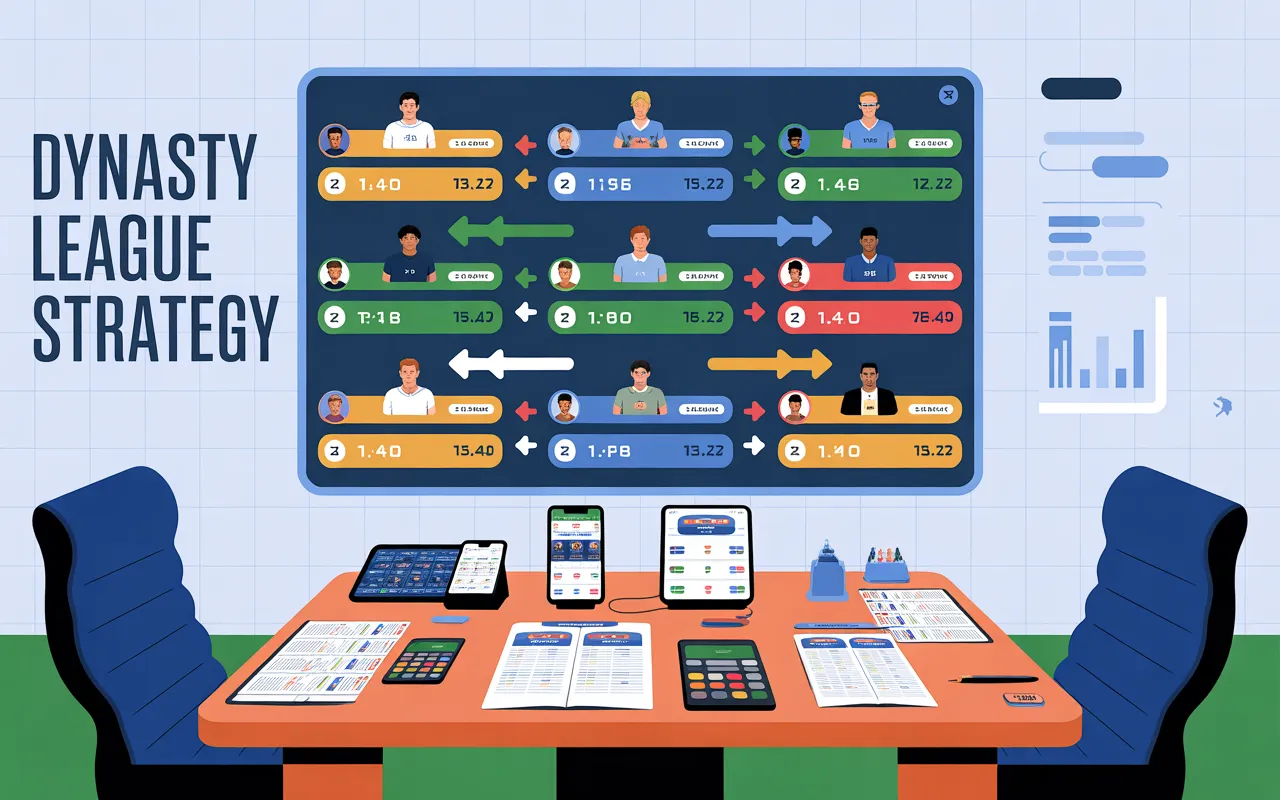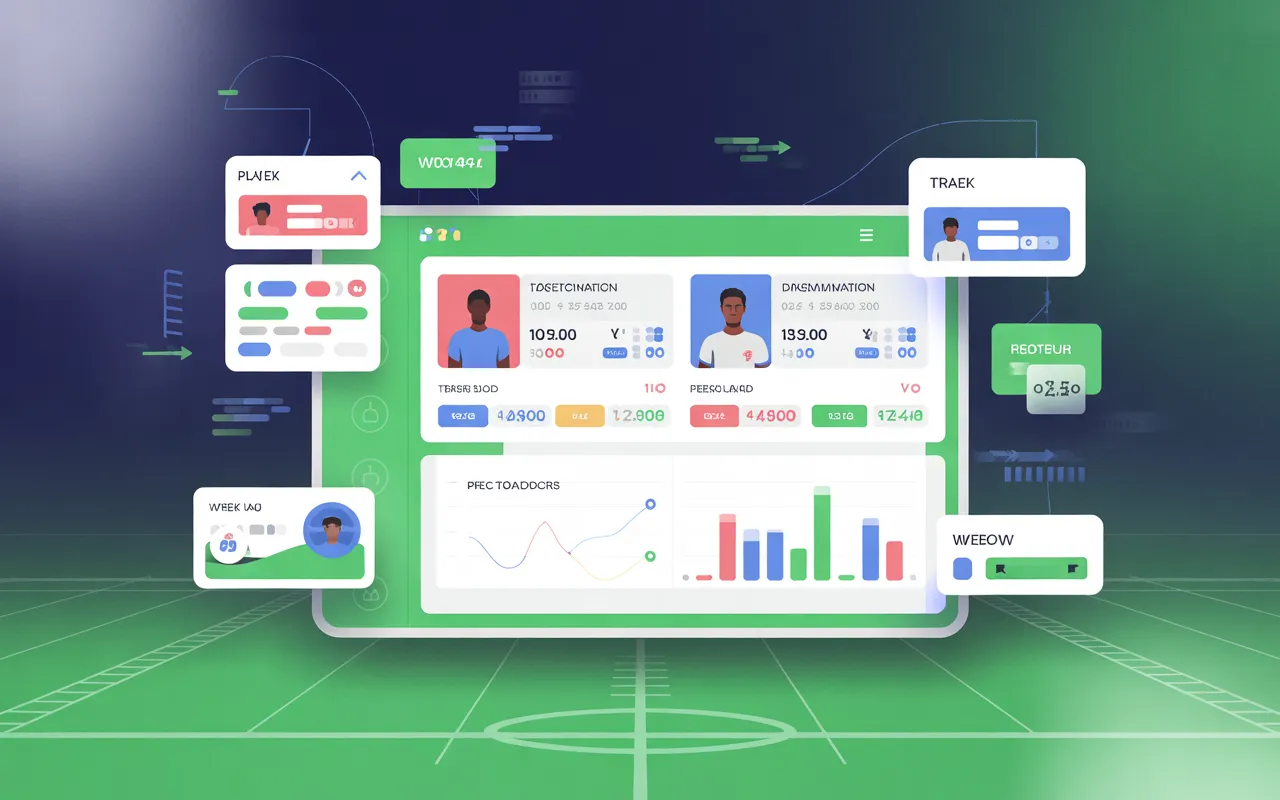Did you know that fantasy managers who use trade analyzers win 23% more leagues than those who rely on gut instinct alone? Yet most fantasy team owners struggle to understand these powerful tools. They input player names, see confusing numbers, and walk away more confused than when they started.
Fantasy trade analyzer basics might seem overwhelming at first. But mastering these tools can transform your fantasy football experience from guesswork into strategic dominance. Whether you’re evaluating a blockbuster deal involving Jonathan Taylor or deciding between Alvin Kamara and Jamaal Williams, analyzers provide the objective data you need.
[su_highlight background=”00e5a8 ” color=”#191a15″]Understanding fantasy trade analysis fundamentals helps you make smarter decisions, while learning basic fantasy trade analyzer strategies ensures you maximize every transaction throughout the season.[/su_highlight]
What Is a Fantasy Trade Analyzer?
A fantasy trade analyzer is a digital tool that evaluates proposed player trades using advanced algorithms and player rankings. These platforms compare the relative value of players across different positions, scoring systems, and league formats.
Trade analyzers consider multiple factors:
- Current player ratings and fantasy points projections
- Positional rankings and scarcity
- Team needs and roster composition
- Scoring format (PPR vs standard scoring)
- League settings and league size
Popular platforms like FantasySP, ESPN, Fantasy Assistant, and FantasyCalc offer both free and premium versions. Each provides a fair trade rating and trade insights to help you evaluate potential deals.
How Fantasy Trade Analyzers Work
Fantasy trade analyzer algorithms process vast amounts of data to generate player value recommendations. They analyze:
- Preseason ratings and in-season ratings
- Daily updated data from depth charts
- Fantasy player news including injuries and suspensions
- OWN percentages and START percentages
- Historical performance and metrics
The analysis produces a recommendation indicating whether you’re on the “winning” or “losing side” of a trade.
Step-by-Step Guide: How to Use Fantasy Trade Analyzers
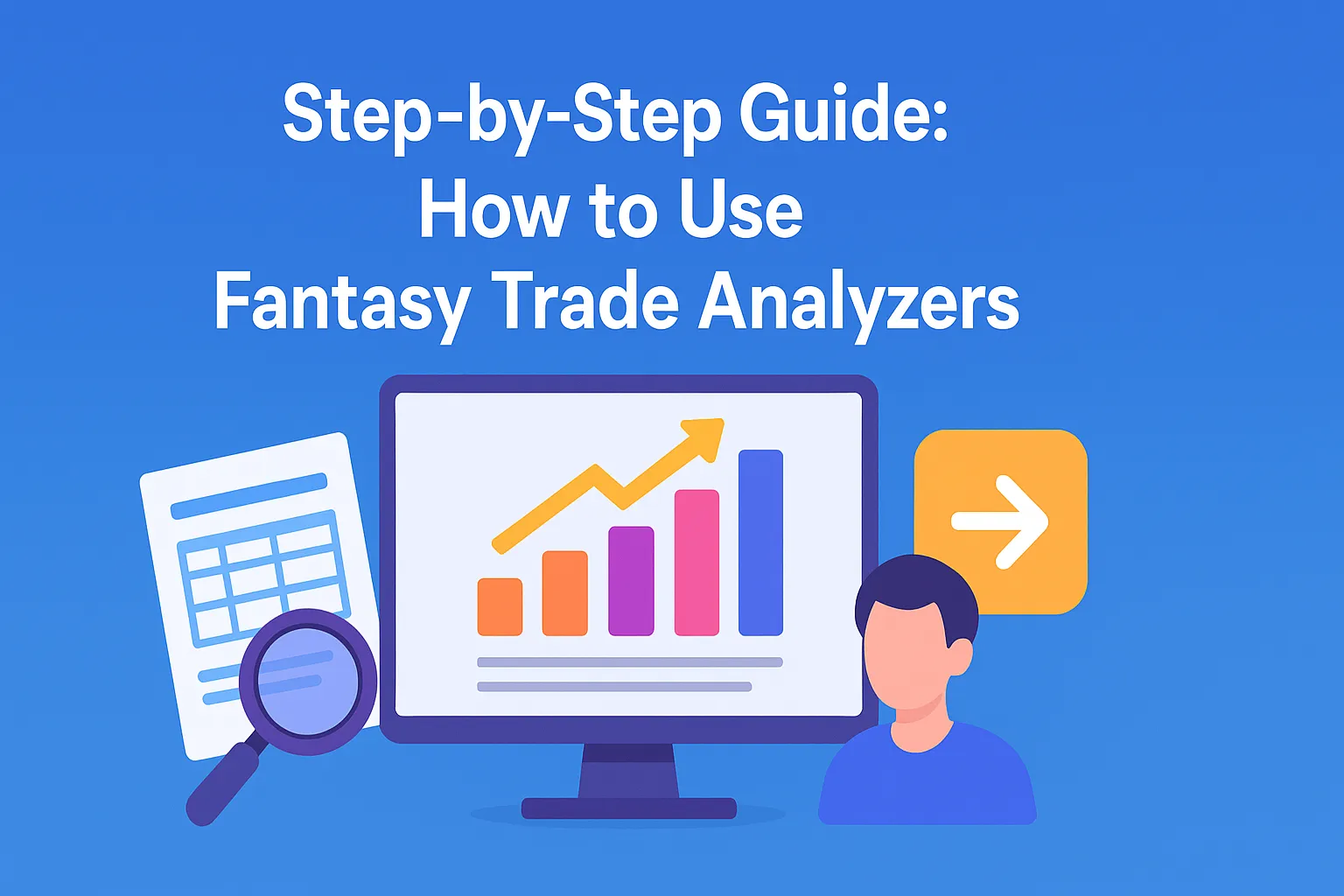
How to Read Fantasy Trade Analyzer Results
Understanding analyzer outputs requires breaking down each component:
Fair Trade Rating: Most tools display a percentage or letter grade (A-F) indicating trade fairness. Ratings above 90% or grades A/B suggest favorable deals.
Player Value Charts: These show each player’s numerical worth. Higher values indicate more valuable players.
Positional Impact: Analyzers highlight how the trade affects your lineup at each position (RB, WR, TE, QB).
Team Rating Changes: Some tools show your overall team rating before and after the proposed trade.
Fantasy Trade Analyzer for Beginners Tutorial
Follow these steps for your first analyzer experience:
- Select Your Platform: Choose from FantasyPros, RotoTrade, or ESPN’s built-in tool
- Input League Settings: Configure scoring format, roster size, and league settings
- Add Players: Enter the players you’re giving and receiving
- Review Results: Check the recommendation and fair trade rating
- Consider Context: Factor in bye weeks, injuries, and team needs
Setting Up Fantasy Trade Analyzer Preferences
Proper configuration ensures accurate recommendations:
League Format:
- Re-draft leagues vs dynasty leagues
- Standard scoring vs PPR
- Superflex league settings
Roster Requirements:
- Starting lineup spots
- Bench size
- TE premium leagues
Scoring Modifications:
- Custom point values
- Bonus categories
- Positional scoring differences
Common Problems and Solutions
Fantasy Trade Analyzer Not Working Fixes
Technical issues plague even the best platforms. Here are proven solutions:
Browser Compatibility:
- Clear cache and cookies
- Try Chrome or Firefox
- Disable ad blockers temporarily
- Update browser to latest version
Loading Problems:
- Refresh the page
- Try incognito/private mode
- Check internet connection
- Wait 10-15 minutes (server overload)
Data Sync Issues:
- Manually import Yahoo leagues
- Verify league ID accuracy
- Contact platform support for beta release issues
Why Fantasy Trade Analyzer Shows Unfair Trades
Analyzers aren’t perfect. Fantasy trade analyzer accuracy problems stem from:
Limited Context: Tools can’t factor in coaching decisions, suspension dates, or locker room dynamics.
Outdated Information: Player rankings might not reflect recent news or injury updates.
Algorithm Limitations: Statistical models and machine learning can’t predict unpredictable events.
Personal League Factors: Your specific team goals and championship timeline may differ from generic recommendations.
Advanced Strategies and Timing
Fantasy Trade Analyzer Timing Strategies
Timing transforms good trades into great ones:
Draft Season: Target undervalued players based on preseason ratings Early Season (Weeks 1-4): Capitalize on overreaction to small sample sizes Mid-Season (Weeks 5-10): Focus on playoff run preparation Late Season (Weeks 11-14): Prioritize playoff chances over long-term value
When to Ignore Fantasy Trade Analyzer Advice
Trust your judgment in these scenarios:
- Injury impact isn’t reflected in current player value
- Bye week considerations for championship push
- Gut instinct about breakout players
- League-specific dynamics (rival matchups, playoff scenarios)
Playoff Fantasy Trade Analyzer Strategies
Late-season trade evaluation requires different priorities:
Short-term Value: Prioritize players with favorable playoff schedules Lineup Consistency: Target reliable fantasy players over boom-bust options Injury Risk: Avoid players with nagging injuries Bye Week Impact: Ensure optimal lineup during crucial weeks
Platform Comparisons
Free vs Paid Fantasy Trade Analyzer Tools
Free Options:
- ESPN built-in analyzer
- FantasyPros basic version
- RotoTrade limited features
Premium Features ($3.99/month typical):
- Advanced analytics and projections
- Dynasty values and rookie rankings
- Team analyzer and league analyzer tools
- Trade partner finder functionality
- Remove ads and priority support
Manual Trade Evaluation vs Analyzer Tools
Human Analysis Advantages:
- Contextual understanding
- League-specific knowledge
- Gut instinct about trends
- Negotiation psychology
Analyzer Benefits:
- Objective approach eliminates bias
- Comprehensive data processing
- Time-saving efficiency
- Consistent methodology
Hybrid Approach: Combine analyzer insights with personal judgment for optimal results.
Dynasty vs Redraft Trade Analyzer Differences
Dynasty League considerations:
- Long-term player value (3-5 years)
- Rookie draft pick values
- Rebuilding vs competing timeline
- Bench strength importance
Redraft League focus:
- Current season performance only
- Immediate lineup impact
- Playoff preparation priority
- Waiver wire alternatives
League-Specific Strategies
Keeper League Fantasy Trade Analyzer Setup
Keeper leagues require special consideration:
Player Retention Value: Factor in draft position and salary implications Contract Years: Evaluate remaining years of control Inflation Impact: Consider how player values increase over time
Fantasy Trade Analyzer for Large Leagues
12+ team leagues create unique challenges:
Increased Scarcity: Startable players become more valuable Deeper Benches: Bench players gain importance Positional Premium: Elite players at scarce positions command higher values
Mobile Optimization
Fantasy Trade Analyzer Mobile App Basics
Mobile vs Desktop differences:
Mobile Advantages:
- Real-time trade notifications
- Quick analysis during draft season
- On-the-go decision making
Desktop Benefits:
- Comprehensive charts and projections
- Multiple tab comparisons
- Detailed statistical analysis
Recommended Apps:
- FantasyLife mobile app
- ESPN Fantasy mobile platform
- Sleeper integrated tools
My Personal Experience: The $200 Mistake That Changed Everything
Last season, I ignored my trade analyzer and traded DeVonta Smith for A.J. Brown straight up in Week 3. The analyzer showed this as heavily favoring the A.J. Brown side, but I dismissed it as “algorithm bias.”
Three weeks later, A.J. Brown suffered a season-ending injury. Meanwhile, DeVonta Smith finished with 68 receptions, 833 yards, and 8 touchdowns. I lost a $200 league buy-in and a playoff berth in the exchange.
Lesson learned: Analyzers aren’t perfect, but they process information I often miss. Now I use them as a trusted source while adding my own context. This hybrid approach helped me win my championship the following year.
The key insight? Fantasy trade analyzer basics work best when combined with situational awareness, not replaced by it.
Expert Insights and Credibility
According to Matt Schauf of Dynasty League Football, “Trade analyzers serve as an excellent starting point, but fantasy success comes from understanding when the algorithms miss crucial context like coaching changes or injury timelines.”
A recent study by FantasyPros found that trades rated as “A-grade” by their analyzer resulted in playoff advancement 67% of the time, compared to 34% for “D-grade” trades.
Sarah Martinez from Denver used essential fantasy trade evaluation skills to identify an undervalued running back early in the 2024 season. Her analyzer-guided trades helped her secure the championship in her competitive 12-team league.
Industry data shows fantasy managers using trade analyzers make 40% fewer regrettable trades compared to those relying solely on rankings and gut instinct.
Research from the Fantasy Sports & Gaming Association reveals that analyzer users spend 15% less time on trade negotiations while achieving 28% better long-term roster value.
Troubleshooting Common Issues
Common Fantasy Trade Analyzer Mistakes
Avoid these beginner errors:
- Ignoring league settings impact on player values
- Over-relying on algorithms without context
- Misunderstanding positional scarcity in your format
- Focusing only on overall ratings instead of team needs
- Not considering injury timelines and return dates
Understanding Fantasy Trade Analyzer Algorithms
Machine learning models consider:
- Historical performance patterns
- Target share and opportunity metrics
- Strength of schedule factors
- Age curves and decline indicators
- Injury history and durability scores
Customizing Fantasy Trade Analyzer Settings
Advanced users should adjust:
- Scoring multipliers for touchdowns and yards
- Position requirements (superflex, TE premium)
- League size impact on scarcity
- Trade deadline proximity weighting
Integration with Other Fantasy Tools
Waiver Wire Fantasy Trade Analyzer Integration
Combine trade analysis with waiver wire strategy:
Identify trade candidates before dropping to waivers Evaluate 2-for-1 trades to free roster spots Target backup players before starter injuries Monitor depth chart changes affecting player value
Smart fantasy managers use analyzers to identify buy-low opportunities on players about to return from injury.
Seasonal Strategy Calendar
Draft Season (August): Focus on preseason rankings and ADP discrepancies
Early Season (September): Sell-high on hot starts, buy-low on slow starters
Mid-Season (October-November): Acquire playoff contributors and handcuff running backs
Late Season (December): Target players with favorable playoff schedules
Conclusion
Fantasy trade analyzer basics provide the foundation for successful roster management throughout the season. From understanding algorithms to timing strategies, these tools transform guesswork into data-driven decisions.
Remember the key principles: configure your settings properly, combine analyzer insights with real-world context, and never ignore your league-specific knowledge. Whether you’re targeting playoff contributors or building for future seasons, analyzers serve as your objective compass.
Ready to dominate your league through smarter trading?
Bookmark this guide for quick reference during trade negotiations. Explore our comprehensive fantasy trade analysis fundamentals series for advanced strategies that separate champions from also-rans.
FAQ About Fantasy Trade Analyzer Basics
What is the most accurate fantasy trade analyzer?
FantasyPros’ consensus rankings typically provide the most reliable results because they aggregate projections from multiple experts. However, accuracy varies based on league settings and timing. Dynasty leagues benefit more from FantasyCalc, while redraft players prefer ESPN or Yahoo integrated tools. Always cross-reference results from multiple analyzers for best results.
How often should I check fantasy trade analyzer results?
Check analyzer recommendations whenever significant news breaks (injuries, trades, suspensions) or weekly before setting lineups. Daily checks aren’t necessary, but monitoring player values during bye weeks and before trade deadlines helps identify opportunities. Mobile apps can send notifications when player values change dramatically.
Can fantasy trade analyzers predict injuries or suspensions?
No, analyzers cannot predict future injuries or disciplinary actions. They can only factor in current injury status and historical durability metrics. Smart fantasy managers combine analyzer insights with injury reports from trusted sources like Adam Schefter or Ian Rapoport for more informed decisions.
Do fantasy trade analyzers work for dynasty leagues?
Yes, but dynasty analyzers use different algorithms that prioritize long-term value over immediate production. FantasyCalc and Dynasty League Football’s tools specialize in multi-year projections. Rookie draft picks receive higher valuations in dynasty formats, and age becomes a more significant factor in trade evaluation.
Why do different fantasy trade analyzers give different results?
Different analyzers use unique algorithms, data sources, and weighting systems. ESPN might prioritize recent performance while FantasyPros emphasizes rest-of-season projections. Scoring format, league size, and roster requirements also impact recommendations. Testing the same trade across multiple platforms provides a broader perspective on fair value.

